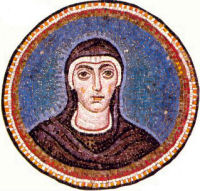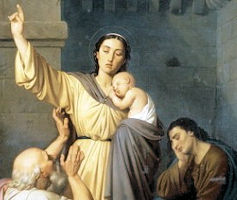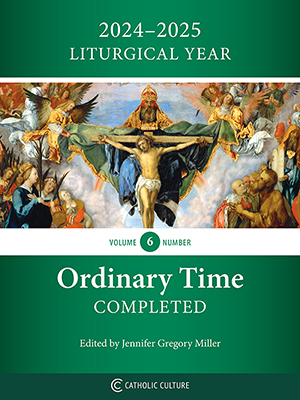Lent: March 7th
Monday of the First Week of Lent; Optional Memorial of Sts. Perpetua and Felicity, martyrs
Other Titles: St. Felicitas
» Enjoy our Liturgical Seasons series of e-books!
Communion Antiphon, Mt 25:40, 34:
Amen, I say to you: Whatever you did for one of the least of my brethren, you did it for me, says the Lord. Come, you blessed of my Father, receive the kingdom prepared for you from the foundation of the world.
The great themes—the annual catechumenate by which all the people of the Church are renewed in the baptismal promises they repeat at the Easter Vigil; the adventure of God in salvation history and in the coming of the Kingdom in the person of Jesus; and the invitation to deeper friendship with Christ through a more intimate embrace of His Passion and Death—shape the liturgical rhythm of Lent.
Ash Wednesday, the days immediately following, and the first two weeks of Lent are penitential in character. The prayers and readings of daily Mass and the Liturgy of the Hours calls us to an extended examination of conscience: How am I living as a witness to the Kingdom? Have I been the missionary of the Gospel I am called to be? What is there in me that needs purification, if I am to deepen my friendship with Jesus? —George Weigel, Roman Pilgrimage: Station Churches
The account of the martyrdom of Saints Perpetua and Felicity forms one of the finest pages of the history of the first centuries of the Church. It shows us clearly the wonderful sentiments of these two women when they heard that they had been condemned to the wild beasts. Knowing their own weakness but relying on the strength of Christ, who was fighting with them, they went to their martyrdom as to a triumphant celebration, to which they were invited by Christ. They were exposed to the fury of wild beasts in the amphitheater at Carthage, A.D. 203, and finally killed by the sword. Their names are still mentioned together in the Roman Canon of the Mass.
According to the previous calendar (1962), today is the feast of St. Thomas Aquinas which is now celebrated on January 28.
Meditation on the Liturgy
This is also the Ember week of Lent: the spring Embertide. The first week of Lent continues the subject introduced on Sunday: temptation. The lessons of the principal and most ancient Masses this week show that every Lenten effort brings results from the Lord: healing, strengthening, conversion. But the effort itself is not the most important thing; it is God's reaction and acceptance. We are like the grain of wheat which must die to become productive. We must die before we grow into glory.
The Mass of today is filled with thought of the last Messianic times, when Christ will gather all those he has redeemed and lead them into his eternal Kingdom. What a wonderful encouragement to those who, with Christ and the Church, have truly entered into the Lenten effort.
Today's Gospel tells us that we must practice charity and do works of mercy to all without distinction and in the name of Christ. When our Blessed Lord comes to us in the Eucharist today he will give us the joy of hearing his invitation to possess the kingdom prepared for us by his Father form the foundation of the world.—St. Andrew Bible Missal
Sts. Perpetua and Felicity
 Vibia Perpetua, a well-to-do young woman and mother, and Felicitas, a slave who gave birth to a child three days before suffering a martyr's death, were catechumens. Against such prospective converts the persecution of Septimius Severus was particularly severe. These two holy women suffered death on the seventh of March in Carthage. The Breviary relates the following touching episode:
Vibia Perpetua, a well-to-do young woman and mother, and Felicitas, a slave who gave birth to a child three days before suffering a martyr's death, were catechumens. Against such prospective converts the persecution of Septimius Severus was particularly severe. These two holy women suffered death on the seventh of March in Carthage. The Breviary relates the following touching episode:
Now the day had arrived when they were to be thrown to the wild beasts. Felicitas began to be sorrowful because she feared she would have to wait longer than her companions. For eight months she had been pregnant and therefore, according to Roman law, could not be executed before the birth of the child. But the prayers of her fellow sufferers hastened her time and she gave birth to a baby girl.
While she was suffering from the pains of childbirth, one of the guards called out to her, "If you are suffering so much now, what will you do when you are thrown to the wild beasts?" "Now I suffer," she answered, "but there Another will be in me, who will suffer for me, because I will suffer for Him." When she was in travail she had sorrow, but when she was set before the wild beasts she rejoiced (Martyrology).
Finally, on the seventh of March, these heroic women were led into the amphitheater and severely scourged. Then they were tossed about by an exceptionally wild cow, gored, and thrown to the ground.
—Excerpted from The Church's Year of Grace, Pius Parsch
Patronage: Perpetua—Cattle; ranchers; death of children; martyrs; married women; Carthage, Tunisia; Santa Perpètua de Mogoda, Catalonia, Spain
Felicity—Cattle; ranchers; death of children; martyrs; sterility; to have male children
Symbols and Representation: Perpetua—cow; woman with a sword beside her; woman with a bull, ox, leopard or lion in an amphitheater; Seven swords; cauldron of oil and sword; sword with seven heads; eight palms
Felicity—bull; cow; pregnant woman holding a cross; woman with a sword by her; woman with a bull or ox in an amphitheater
Highlights and Things to Do:
- The story of the sufferings of today's saints is preserved for us in authentic "Acts of the Martyrs" that were composed partly by the saints themselves, and partly by eyewitnesses (perhaps Tertullian). The account may be classed with the most beautiful portions of ancient Christian literature that have come down to us. Read CIN's account.
- Read about the locations of their relics.
- Read more about Sts. Perpetua and Felicity:
- Watch Sts. Perpetua and Felicity.
- Listen to Catholic Culture's Way of the Father's podcast, Ep. 15—Perpetua: A Rare Female Voice from Antiquity by Mike Aquilina.
- Listen to Catholic Culture's Audiobook Tertullian—The Martyrdom of Perpetua and Felicity by James Majewski.






